How does DEV operate on the chain? Using Cocoro as an example to explain the activities on the EVM tether

Reprinted from panewslab
03/10/2025·2MThe day before yesterday, Gou Mom posted a new article on her blog , adopted a new dog, and cooperated with the Own The Doge community to launch the official token $cocoro, which is deployed in the BASE chain, with the contract address of 0x937a1cFAF0A3d9f5Dc4D0927F72ee5e3e5F82a00 .
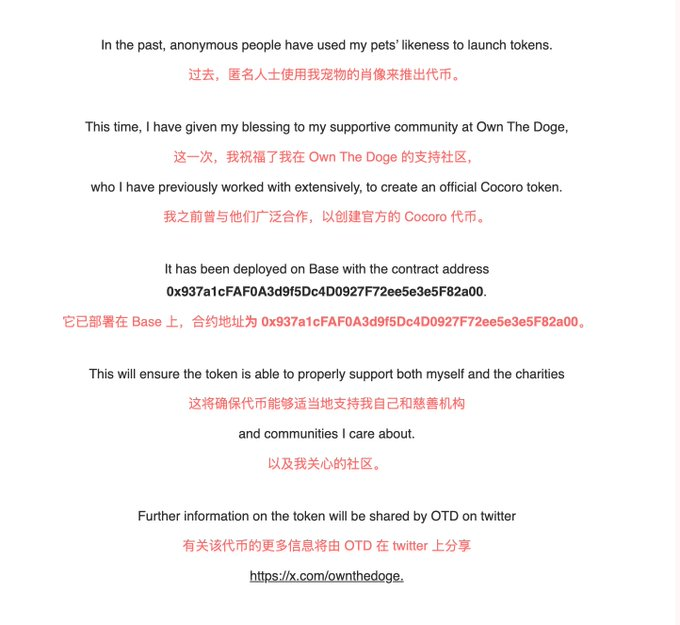
After this article was published, the price of tokens has been rising, with a market value exceeding 100M within an hour. This article will explain the various operations of dev on the chain step by step.
1. How to verify the allocation of token economics
We can see $cocoro's token economics in the official recommendations of the Own The Doge community, with 75% adding LP, 20% community airdrop, and 5% DAO reserve.
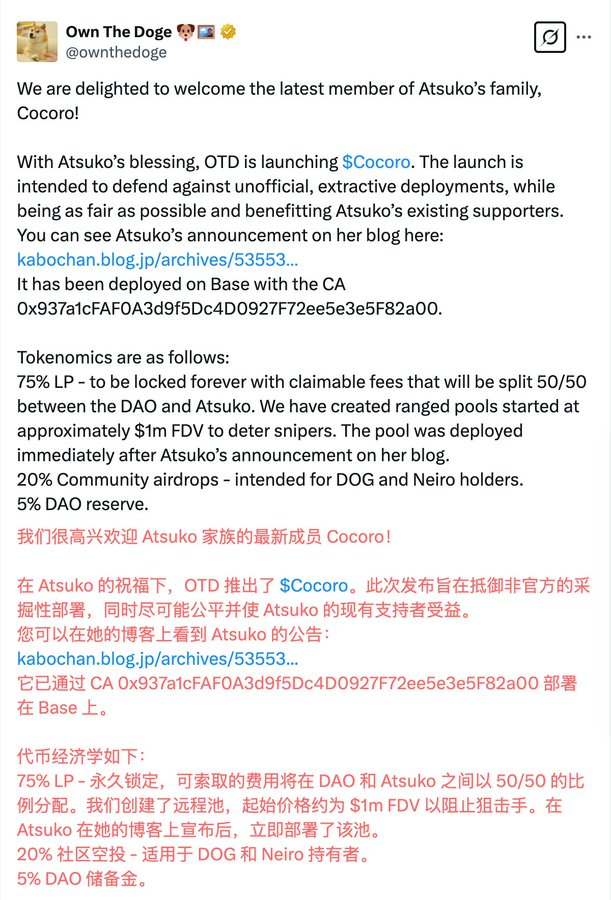
When we see the token economics above, how do we verify that dev is correctly allocated by token economics?
Commonly used tools have limited support for BASE chains. Currently, the best and easy-to-use tool to view changes in the fund pool is okx.
We open the okx web version and enter the CA of $cocoro ( https://www.okx.com/zh-hans/web3/detail/8453/0x937a1cfaf0a3d9f5dc4d0927f72ee5e3e5f82a00 ). In the [Fund Pool Change] column, you can see all the pool addition and pool reduction operations. For [Time] in positive order, you can see the earliest two pool addition operations, each with 375M of $cocoro one-sided pool. The number of these two transactions is exactly 75%, which is consistent with the description in token economics.
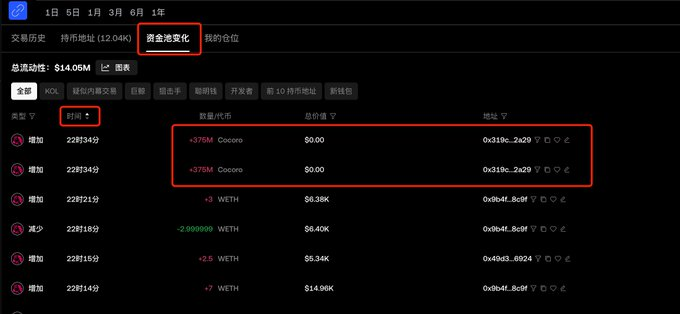
You can see the address holding status in the [Coin Holding Address] column. The position of the second address on the list was 25% when it first went online, which is in line with 20% of the community airdrop and 5% of the DAO reserve in token economics. The second address in the picture shows that the position is 26.38%, which is more than 25% because the dev receives the handling fee for adding pools, and the coins have become more.
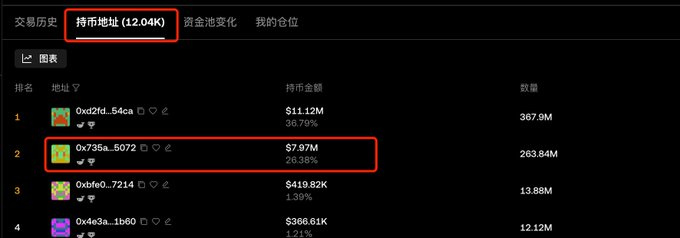
2. How to view the operation of dev
Several commonly used tools perform the recognition and operation of BASE chain dev addresses in a normal manner, and we can use a block browser to analyze it.
1. Find the dev address
Open the block browser and enter the CA of $cocora ( https://basescan.org/address/0x937a1cfaf0a3d9f5dc4d0927f72ee5e3e5f82a00 ). In the home page [More Info] column, we can see the contract creation information, including the dev address, the transaction hash created by tokens, and the fund source address. From the figure, we can know that the dev address is 0x319C399d3D7d7A2972a6A59646A060Bb29d82A29
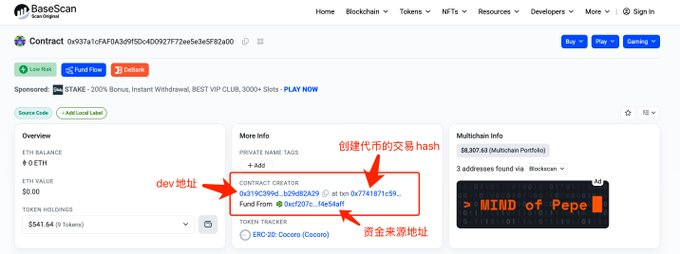
2. Check the operation of dev
Enter the dev address 0x319C399d3D7d7A2972a6A59646A060Bb29d82A29 in the block browser ( https://basescan.org/address/0x319c399d3d7d7a2972a6a59646a060bb29d82a29 ), open the [Token Transfers(ERC-20)] column, and only look at the transactions listed as "ERC-20: Cocoro" in [Token]. Each transaction from the bottom to the top is:
a. Create tokens and mint 1B of tokens
b. Transfer 1 token to the test address to verify that the function is normal (it means that dev is still very cautious)
c. Transfer 1 token transferred to the test address back to the dev address
d. The two transactions add 375M tokens to a single-sided pool (corresponding to the first part of adding pools)
f. Transfer the remaining 250M tokens to address 0x735A2Ea69997e668dD0f4b2a30fFa9f01e045072
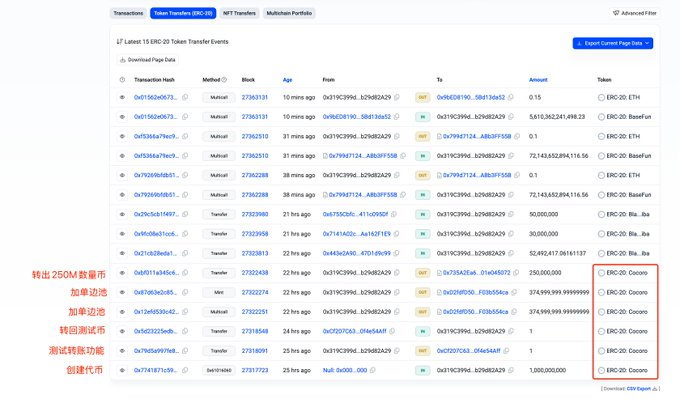
3. Check LP Attribution
Adding a pool in Unisawp V3 will automatically mint an NFT. This NFT records the details of the pool. Having this NFT means having the corresponding pool. You can transfer the ownership of the pool by transferring the NFT. Locking the pool is also operated by operating on the NFT.
Open the [NFT Transfers] column in the previous section dev address to see the NFT transfer situation. Each transaction from bottom to top is:
a. The two transactions at the bottom are to add a one-sided pool, and the corresponding NFTs of mint are compared to the transactions d in the previous section.
b. Transfer the NFTs of the two pools to the address 0x735A2Ea69997e668dD0f4b2a30fFa9f01e045072
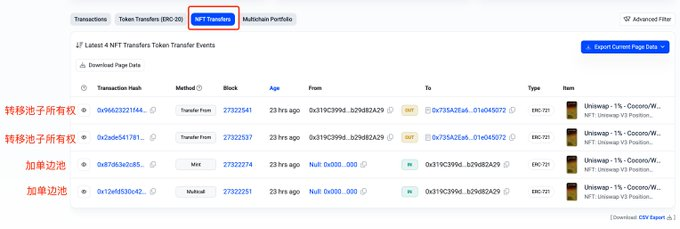
For two transactions in a, we open any transaction and view the transaction details to obtain the Token ID of the NFT. For example, open the last transaction in the picture above ( https://basescan.org/tx/0x12efd530c4245216596993c780075770484622cd68e9cd85e18497bf93bacd81
), check the details and you can see that dev transfers 375M coins to an address, but does not transfer weth, which means that this is a single-sided pool added, not a bilateral pool. In the following section, you can see that the Token ID of the corresponding NFT of this pool is 2256046, as shown in the figure.
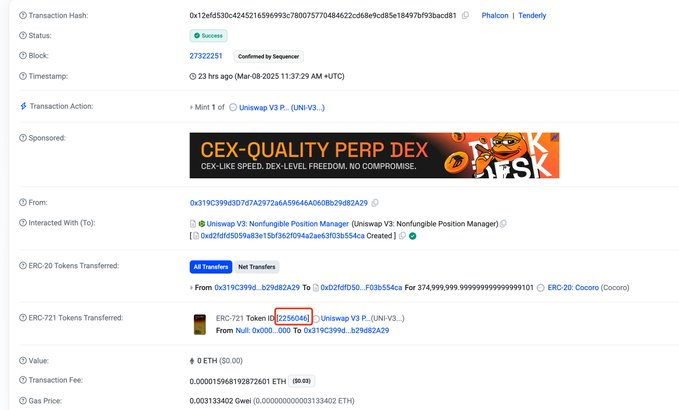
Similarly, we can check that the Token ID corresponding to another pool transaction is 2256052.
4. Verify whether the pool is locked
The official recommendation of Own The Doge community mentioned that 75% of LPs are permanently locked, so how do you check if there is a lock? Through the previous section, we know that dev transfers ownership of the pool to address 0x735A2Ea69997e668dD0f4b2a30fFa9f01e045072, so we need to check whether this address has the behavior of locking the pool.
Enter this address in the block browser ( https://basescan.org/address/0x735a2ea69997e668dd0f4b2a30ffa9f01e045072 ) and check the transactions in the [Transactions] and [Token Transfers (ERC-20)] sections. No transactions related to lock pools were found, which means that the lock pools mentioned in the official recommendation have not been done at present. I only saw an operation to collect the handling fee ( https://basescan.org/tx/0x316d0ea27ae38fd33b694e2bb444c5ec1567a56b7e4b403ec257d3c0ccb1a124 ), and the handling fee received was about 1.7 million u.
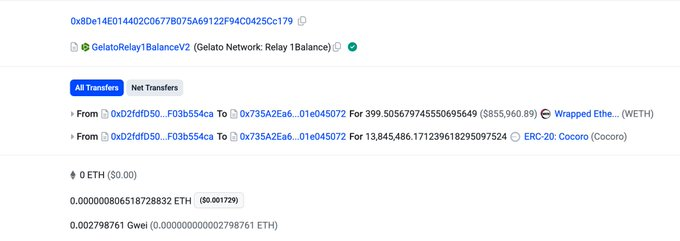
3. How to view the detailed information of LP
From the above, we can see that dev adds two single-sided pools at the beginning. So how do you view the detailed information of these two single-sided pools, such as the interval price and the incurred handling fees?
1. Use the official Uniswap APP
Open the Uniswap website https://app.uniswap.org/ , download the corresponding APP according to the mobile phone type, in the wallet settings [Add Wallet]-[Add Wallet for View only], enter the address that owns the pool 0x735A2Ea69997e668dD0f4b2a30fFa9f01e045072.
In the upper right corner of the Uniswap website, select [Scan the QR code for the Uniswap mobile terminal to connect]. The QR code appears on the page. Use Uniswap on your phone to scan and click "Connect"
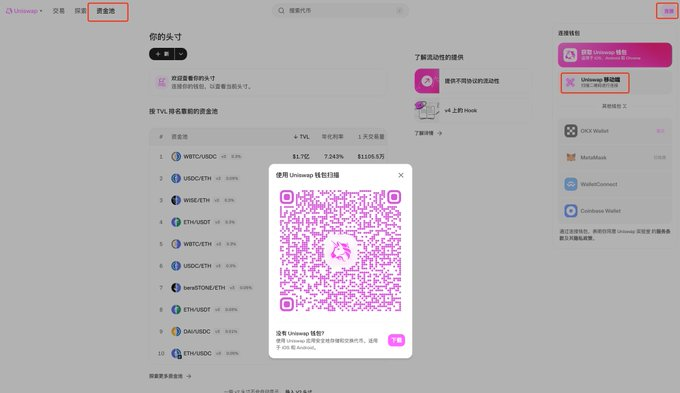
After the scan is successful, the wallet is connected to the web page. You can see the connected wallet address in the upper right corner of the web page. You can see the pool information in the [Fund Pool] column. There are two pools about $cocoro, one of which has exceeded the range and the other is within the range.
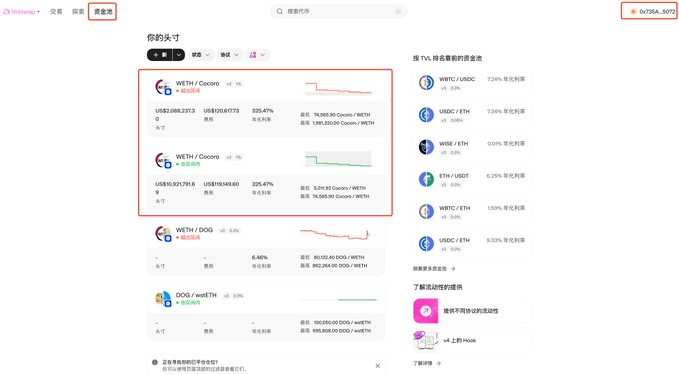
Click the pool to see detailed information, such as the lowest price, highest price, current price of the price range, and the number of weth and cocoros remaining in the pool, as well as the unpaid handling fee.
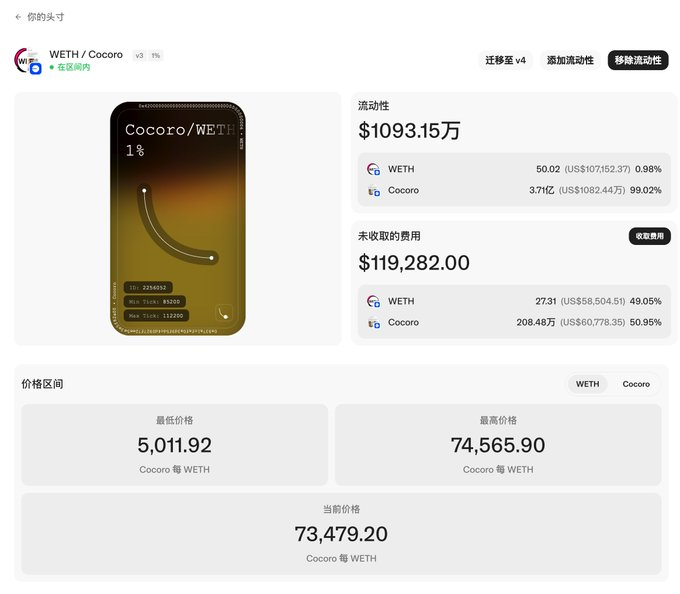
Currently, the unpaid handling fees in the two pools are 120,000 u and 119,000 u respectively. According to the content of Chapter 2, Section 4, it is known that the handling fees received are 1.7 million u. The project party currently earns a total of 1.94 million u on the handling fees.
The advantage of this viewing method is that Uniswap native support, and the disadvantage is that you need to download the APP.
2. View the URL directly
Through the viewing method in the previous section, we can know that the URL of the pool is " https://app.uniswap.org/positions/v3/base/2256046 ", where the number of the last part of the URL is the Token ID of the NFT. In Chapter 2, Section 3, we have found that the Token IDs corresponding to the NFT of the two pools are 2256046 and 2256052 respectively, so we can construct the viewing URLs of the two pools respectively, that is:
https://app.uniswap.org/positions/v3/base/2256046
https://app.uniswap.org/positions/v3/base/2256052
The two URLs above can query the detailed information of the pool.
The advantage of this method is that it is easy to view the URL, but it is necessary to query the Token ID of the NFT corresponding to the pool in advance.
3. Use impersonator to simulate
Impersonator is an open source project ( https://github.com/impersonator-eth/impersonator ) that can simulate any Ethereum address login to the dapp via WalletConnect or iFrame.
Open the official website of impersonator https://impersonator.xyz/ and you can see that you need to fill in the wallet address and select the link. Here, fill in the wallet address 0x735A2Ea69997e668dD0f4b2a30fFa9f01e045072, select "Base" in the chain. Three simulation methods are supported below: "WalletConnect", "iFrame", and "Extension".
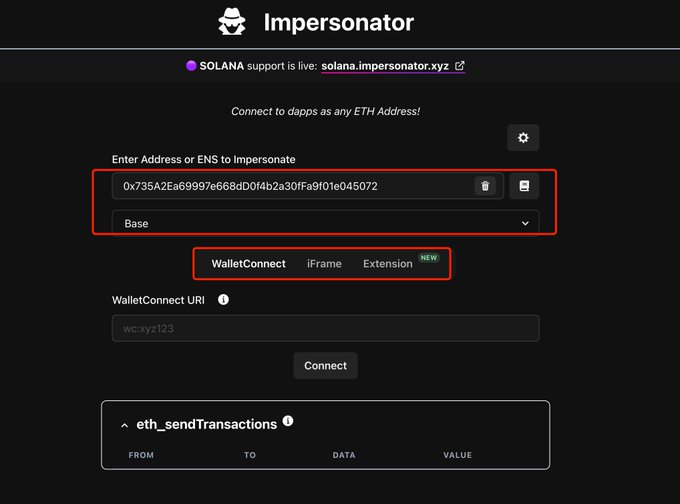
(1) WalletConnect method
Using WalletConnect, we need to open the Uniswap web page first, and select [WalletConnect] in the upper right corner.
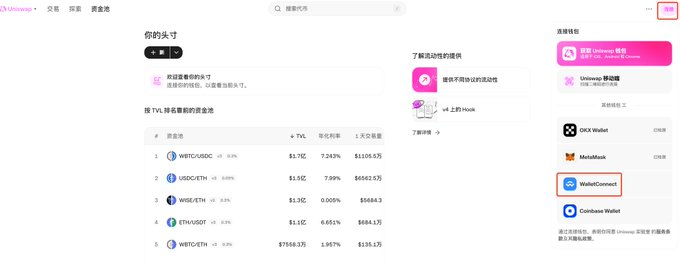
Click Copy in the WalletConnect QR code page that appears, and paste the content into the "WalletConnect URI" in the impersonator website. At this time, the Uniswap website will be connected to the address entered above, and you can view the pool information.
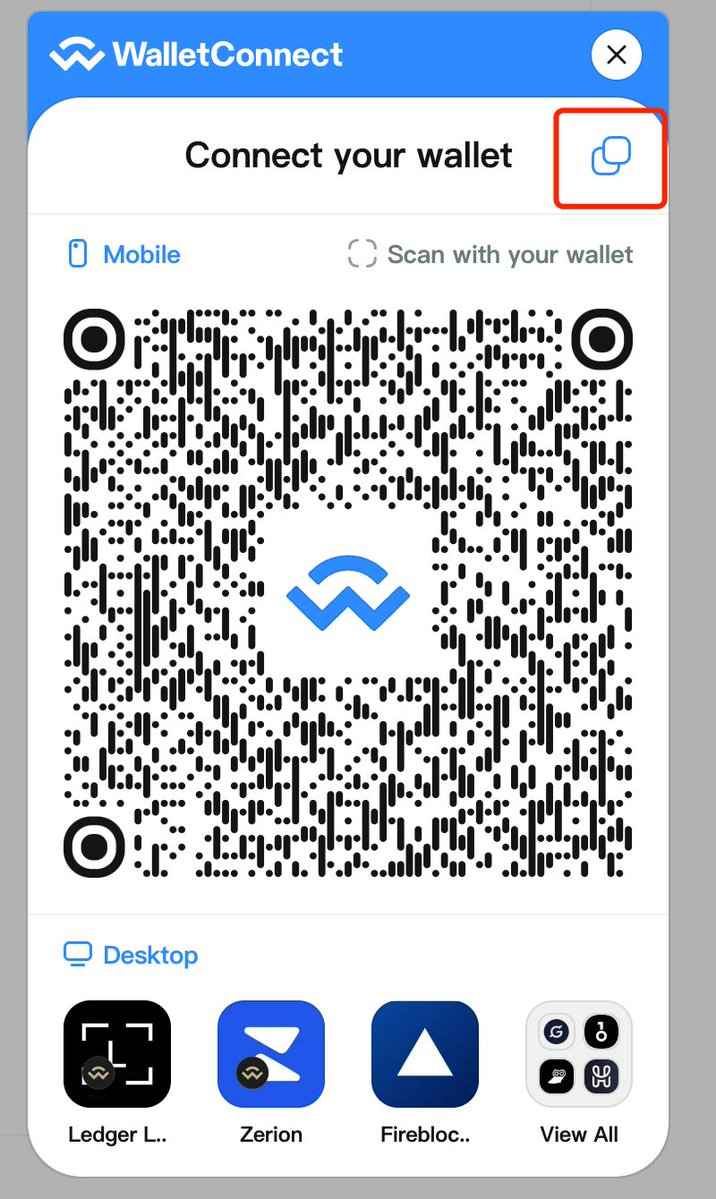
(2) iFrame method
It is relatively simple to select iFrame. You can directly enter the Uniswap URL at "dapp URL" and click "Connect" to see the URL interface for Uniswap to connect to the wallet below. You can view the detailed information of the pool at this time.
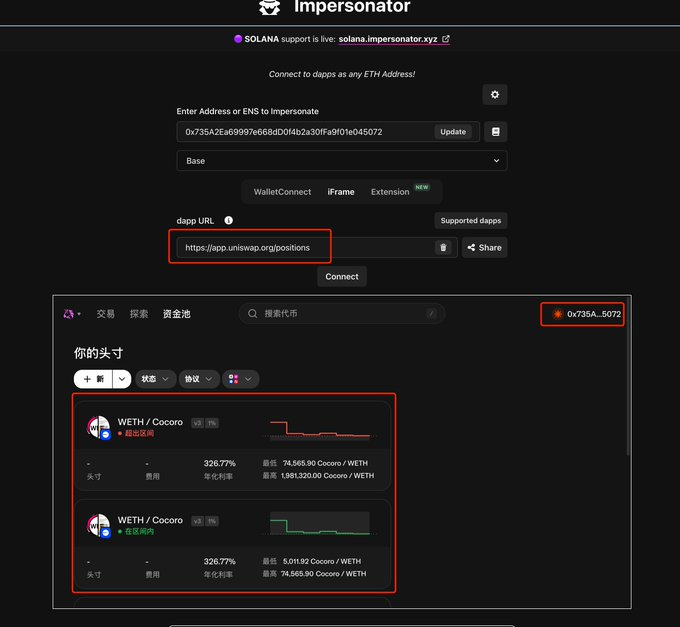
This method may not be supported. If it is not supported, you can choose the WalletConnect method in the previous section to view it.
The "Extension" method is simulated through plug-ins, and no research is done here.
Impersonator currently supports simulated login dapps for solana chain wallet, but currently only supports WalletConnect. Our previous article "Step-by-step teaching: Quickly mastering the viewing method of Meteora liquidity price range"
Chapter 2: Choose to use the Observation Wallet to view it. At this time, you can use the impersonator to simulate login. Unfortunately, Meteora does not currently support WalletConnect connection.

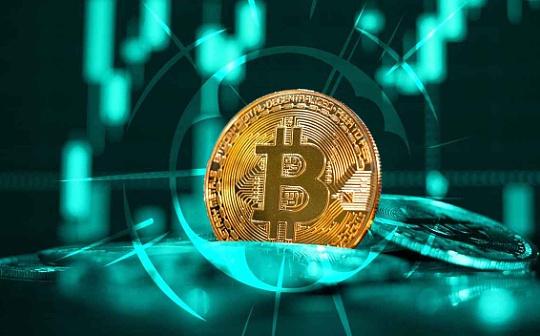
 jinse
jinse

 chaincatcher
chaincatcher